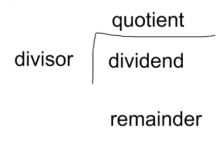Dividing is equitable distribution, i.e. splitting between equal parts or groups.
What is division?

- Dividend: The number that you have to divide.
- Divisor: The number that the dividend is being divided by
- Quotient: The result of the division.
- Remainder: What is left over after the division
Dividing with No Remainders
We want to distribute these 12 balls into 3 boxes in equal parts, therefore there must be the same number of balls in each of the boxes.
 Let’s start distributing the balls in each box until finally there are 4 balls in each box.
Let’s start distributing the balls in each box until finally there are 4 balls in each box.

So the division we have done is 12 balls / 3 boxes = 4 balls in each box.
Division is an inverse operation to multiplication and can be considered as repeated subtraction.
For example if we divide 12 by 3:
12 – 3 = 9
9 – 3 = 6
6 – 3 = 3
3 – 3 = 0
The number of times we can subtract 3 from 12 is 4, so 12/3 = 4.
Dividing with Remainders or Inexact Divisions
The remainder is the amount left over after dividing one number by another.
For example: if we divide 5 balls between 2 boxes, we have two balls in each box and we are left with one, so 5/ 2 = 2 and the remainder is 1.

In Smartick you can find many division problems with or without remainders. Join in and practice elementary math in a fun way!
Learn More:
- What Is a Division? Basic Concepts
- Division Exercises: Learning the Concept of Division
- How to Solve a Problem Involving Dividing 2 Digit Numbers
- Learn the Difference between Exact and Inexact Division
- Learn How to Subtract with Examples








It really helps! Thanks for this.